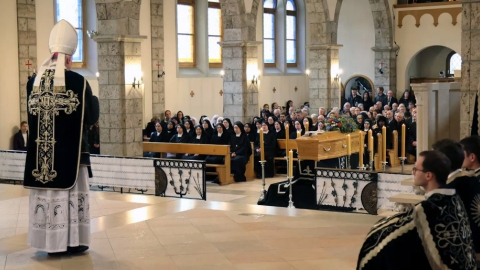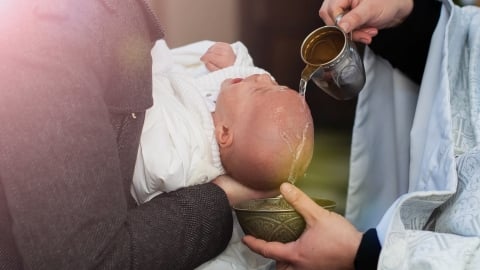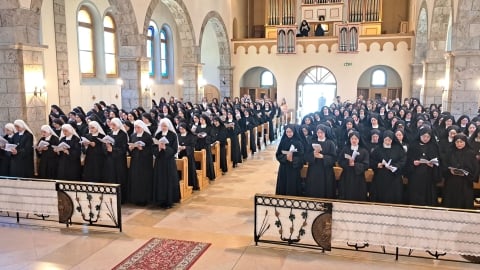The Renovation of St. Vincent's Church in Kansas City, MO

Recently, the long-awaited and necessary renovations of the church, which was constructed starting in 1922, were completed. Fr. Michael Goldade, Prior of St. Vincent's, discusses how the SSPX secured its future for the next generations of Catholics.
Securing Our Future
What was St. Vincent’s like when the Society of Saint Pius X took ownership?
In 1975, the Vincentians, who had cared for the parish for about 100 years, left the premises and the diocese took possession and closed the magnificent church. In the last years, before the Society took ownership, the church fell into disrepair. In 1980, St. Vincent’s was purchased by the SSPX. Parishioners recall the filth and extensive cleaning that was necessary for basic use. The evidence is clear that more substantial repairs were necessary, but in the early years of the new ownership it was hard to afford much more than aesthetic work and localized patchwork.
How urgent were the repairs?
For a long time it was known that significant restoration was necessary on the roof and walls of the church, especially in the higher reaches of the building because of the greater exposure to the weather. Every rainstorm and snowmelt brought out the whole storage of buckets to answer the leaks. Various fundraising and restoration plans were presented, and finally in 2014 a full-scale capital campaign was launched. Under the patronage of St. Vincent de Paul, generous parishioners raised $1,000,000 with the professional services of a company named Church Development.
Talk about the fundraising. Was it welcomed by the parish?
I was somewhat surprised and very encouraged to see the near universal desire to contribute to the effort. I really believe that the parish understood that this was more than a stone and mortar restoration; it was a reminder and a revival of the mission for tradition. In fact, there seemed to be more talk about the history of tradition in the wake of Vatican II than about the building itself. People are more willing to sacrifice for a worthy cause than for a building. There is no question that the experience elevated the spiritual life of the parish.
What steps were taken in the restoration of the church?
Our priorities were always very clear: fix things from the outside to the inside and from top to bottom. The usual process of securing at least three bids with the necessary professional references was maintained. We really wanted quality work on a historical building with historical materials. In the end the contractors retained for the work were: Western Roofing, whose quality work had been proved at the local Franciscan Convent, replaced seven hundred pieces of slate; Mid- Continental Restoration Co. replaced the masonry in areas where it had nearly completely disintegrated. They preceded this with an acid wash of all limestone on the church. The building hardly looked a day old after that process.
Inside, the massive effort to replaster the walls was undertaken by Retro Pro. This was a wellcoordinated process which involved sectioning off portions of the interior space such that liturgical functions could still be conducted around the work. In addition to the new plaster, old paint was removed from the stone window frames exposing the natural limestone as part of the decor. Historic Kansas City, a local group of preservationists, awarded the 2019 Preservation Award to Retro Pro and St. Vincent’s.
Were there other site improvements made?
This massive project inspired minor improvements along the way. A fresh asphalt parking lot was laid, windows and chandeliers were cleaned, and there will be more touches along the way.
What have been the benefits for the parish?
We understand that people are more important than projects, but the beauty of God’s house increases the glory of God and the edification of souls. Beauty inspires, and there is no question that there have been spiritual benefits with still more fruits to come.
Honoring Our Past - History of St. Vincent's
The history behind St. Vincent’s Church in Kansas City is connected with the origin of the diocese of Kansas City in the 1880’s when the first bishop asked the Vincentian Fathers to establish a first parish. A small structure was built across Flora Avenue (on the present parking lot) which was turned into a parish hall later on. The present church was built next to the Georgian-style high school building, and Bishop Thomas Lillis blessed the cornerstone in 1922.
Architect Maurice Carroll gave indication of the grand scope of the project. It would be a “pleasing departure in church design and constructed after the English Gothic school of the 16th century, which adapts itself splendidly to use of the local limestone.”
Indeed, the aim of the architects in designing the new St. Vincent’s Church, was to produce a true Gothic church, not a Gothic cathedral with a wealth of ornament, such as only a large diocese should attempt, but a Gothic parish church, with the classic lines and decorative designs of Gothic. The interior was carefully arranged so worshipers’ focus would be on the high altar, hence minimal ornamentation was in the nave, while a balanced array of Tudor Gothic details comprised the high altar’s fumed-oak reredos. Also incorporated were recessed stations, a lack of niches to avoid superfluous statues, and elegant, but simple, stained-glass windows. Other features included distinct Lady and St. Joseph chapels (as opposed to side altars), two spacious sacristies, a baptistery, shrine area, and a crypt chapel that seats 200 persons. For the 1920’s, its construction was also avant-garde. The limestone-clad structure was the first steel-reinforced concrete church in Kansas City. Modern conveniences were included— a forced air system for heating and natural cooling, and central vacuuming. The bulk of construction was completed by mid-1924 at the cost of $230,000 (which in today’s currency would be $2.5 million, though it would take $30 million to build it now).
The complex had been built big as substantial parish growth had been expected, but due to the Depression, this never occurred. Shifting demographics in the 1950’s, caused by suburbanization, only worsened matters. During the 70’s, the diocese divided up the complex and twice attempted to sell the church to Protestant groups but failed. By that time, Protestant “Bishop” Penn had acquired the academy building.
In the summer of 1975, Fr. Hector Bolduc was celebrating Mass regularly in Springfield, Missouri, and offered to come regularly to Kansas City, dedicating the group to St. Michael the Archangel, going from garage to former Protestant churches to Betty’s Floral Shop in Grandview, Missouri. Bishop John Sullivan had been approached about purchasing one of the recently closed churches, but vowed never to sell one to the SSPX. Finally, a third-party sale was made through Bishop Penn, who had an option to buy the church, and on Ascension Thursday, May 15, 1980, St. Vincent’s was purchased by the SSPX for a mere $60,000.
A few days later on May 23rd, Archbishop Lefebvre echoed the words “C’est magnifique! It is a Cathedral!” within the spacious nave of St. Vincent’s, currently the largest church the SSPX owned anywhere.
On May 9, 1981, Archbishop Lefebvre solemnly blessed St. Vincent’s, rededicating it to Catholic worship. Then in keeping with his designation of St. Vincent’s as the SSPX’s “Episcopal Church,” the Archbishop conferred Holy Orders. Only one more ordination—of Fr. Benjamin Campbell—took place in 2008.
Gradually, through time, St. Vincent’s academy was purchased in 1989, and later on the next-door rectory, while the District House had moved from St. Louis to Kansas City, on Tracy Avenue in 1991. Presently, the priory is located in the next-door rectory and the academy hosts the boys’ school while the girls school has moved to the newly purchased Tracy campus.
Regina Coeli Report Feb-Mar 2021 / sspx.org














